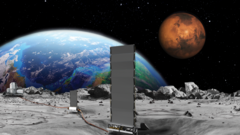In a recent announcement, US media reported that NASA will push forward with its Fission Surface Power Project to create a nuclear reactor on the Moon, aiming for its deployment by 2030. This initiative reflects the US goal of establishing a permanent human settlement on the lunar surface, especially in light of similar ambitions from nations like China and Russia, which could declare exclusive zones on the Moon if they advance their space programs.
Acting NASA Administrator Sean Duffy has emphasized the critical need for robust energy solutions to support a future lunar economy and enhance national security, urging commercial companies to propose designs for reactors capable of generating at least 100 kilowatts of power. For context, while this is a relatively modest output compared to typical wind turbines that produce 2-3 megawatts, nuclear power remains a compelling option for consistent energy across the lunar day, which consists of two weeks of sunlight followed by two weeks of darkness.
Though the concept of lunar nuclear reactors is not new—NASA awarded contracts last year to design such reactors—expert voices in the scientific community express concerns about the realism of this timeline, especially following significant budget cuts to NASA initiatives. Dr. Sungwoo Lim of the University of Surrey notes that megawatt-scale power generation is essential for sustaining human habitats on the Moon, asserting, "Nuclear energy is not just desirable; it is inevitable."
Experts like Professor Lionel Wilson of Lancaster University believe it is technically feasible to deploy the reactors by the 2030 deadline if sufficient funding is secured. However, the safety risks associated with launching radioactive materials raise additional challenges that must be navigated.
The urgency behind Duffy's appeals coincides with political goals amid a new space race, reminiscent of past competitive eras. Critics, such as Dr. Simeon Barber from the Open University, express concerns that focusing on national interests could overshadow collaborative scientific exploration beyond Earth. The potential for China and Russia to stake claims on lunar territory, as hinted at in the Artemis Accords—which aim to establish cooperative principles for lunar operations—may also complicate the pursuit of shared exploration.
The upcoming Artemis 3 mission, slated to land humans on the Moon in 2027, faces challenges and setbacks, prompting questions about how these ambitious nuclear plans align with the overall roadmap for lunar exploration. "If you've got nuclear power for a base but no means to transport people and equipment, it won't serve its purpose," Dr. Barber concluded.
Acting NASA Administrator Sean Duffy has emphasized the critical need for robust energy solutions to support a future lunar economy and enhance national security, urging commercial companies to propose designs for reactors capable of generating at least 100 kilowatts of power. For context, while this is a relatively modest output compared to typical wind turbines that produce 2-3 megawatts, nuclear power remains a compelling option for consistent energy across the lunar day, which consists of two weeks of sunlight followed by two weeks of darkness.
Though the concept of lunar nuclear reactors is not new—NASA awarded contracts last year to design such reactors—expert voices in the scientific community express concerns about the realism of this timeline, especially following significant budget cuts to NASA initiatives. Dr. Sungwoo Lim of the University of Surrey notes that megawatt-scale power generation is essential for sustaining human habitats on the Moon, asserting, "Nuclear energy is not just desirable; it is inevitable."
Experts like Professor Lionel Wilson of Lancaster University believe it is technically feasible to deploy the reactors by the 2030 deadline if sufficient funding is secured. However, the safety risks associated with launching radioactive materials raise additional challenges that must be navigated.
The urgency behind Duffy's appeals coincides with political goals amid a new space race, reminiscent of past competitive eras. Critics, such as Dr. Simeon Barber from the Open University, express concerns that focusing on national interests could overshadow collaborative scientific exploration beyond Earth. The potential for China and Russia to stake claims on lunar territory, as hinted at in the Artemis Accords—which aim to establish cooperative principles for lunar operations—may also complicate the pursuit of shared exploration.
The upcoming Artemis 3 mission, slated to land humans on the Moon in 2027, faces challenges and setbacks, prompting questions about how these ambitious nuclear plans align with the overall roadmap for lunar exploration. "If you've got nuclear power for a base but no means to transport people and equipment, it won't serve its purpose," Dr. Barber concluded.

















